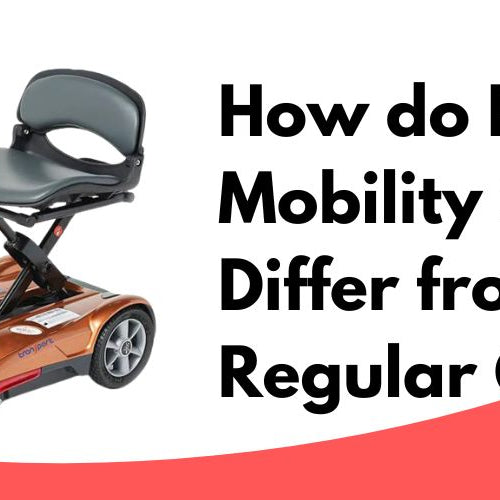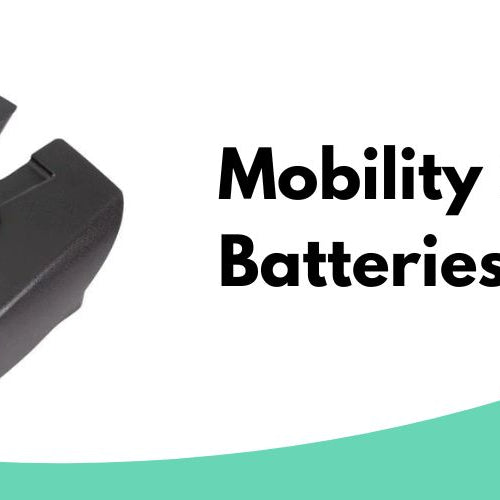Traveling with a mobility scooter can be a liberating experience, allowing individuals to maintain their independence while exploring new destinations. One might wonder if taking a mobility scooter on a train is possible, and the good news is that it usually is, but there might be some guidelines to consider. In this article, we'll discuss the key points to take into account when planning to bring a mobility scooter on a train journey.
Many train operators make an effort to accommodate passengers with mobility scooters, but it is essential to check ahead with the specific train company. While some trains have designated spaces for mobility scooters, others may require passengers to fold their scooters and store them as luggage. A popular option for train travel is the Triaxe Sport, which has been recommended by individuals who frequently use mobility scooters on trains.
Another factor to consider is the size and weight of the mobility scooter, as this can impact its compatibility with train travel. For example, the FreeRider USA Luggie Golden Elite Scooter weighs just 55 lbs., including its battery, and can support a 320 lbs. weight capacity. This makes it suitable for most train services, but passengers should always confirm the specific requirements of their chosen route and train operator to avoid any potential issues.
General Rules for Mobility Scooters on Trains
Size and Weight Restrictions
When considering taking a mobility scooter on a train, it's important to adhere to the size and weight restrictions set by the train providers. Generally, these restrictions allow for mobility scooters with dimensions that do not exceed 700 millimeters in width and 1200 millimeters in length. The combined weight of the scooter and its user should also not surpass 300 kilograms. It might be wise to check with the specific train provider or local regulations before planning to travel with a mobility scooter.
Battery Requirements
Mobility scooters are typically powered by rechargeable batteries. One should ensure that their mobility scooter's battery is fully charged before embarking on a journey by train. It's essential to be aware that some train providers may have specific guidelines and requirements on the type of batteries allowed on board, such as dry or gel cell types. Be sure to comply with these rules and consider carrying a copy of the scooter's technical specifications to have handy if needed.
Scooter Security and Storage
When traveling with a mobility scooter on a train, one must prioritize the scooter's security and storage. Most train providers offer designated storage areas for mobility scooters and wheelchairs. In some cases, a mobility scooter might need to be folded and stowed in the luggage compartment. It's crucial to familiarize oneself with the train's facilities and procedures for stowing mobility scooters, especially when using a new rail service.
For security purposes, remember to always have the scooter's keys and any necessary documentation, such as user manuals or permits. Additionally, make a point to inquire about potential assistance or the use of ramps, bridge plates, or station-based mobile lifts when boarding or disembarking the train.
In summary, to confidently and comfortably travel with a mobility scooter on trains, be aware of size and weight restrictions, battery requirements, and scooter security and storage practices. Always refer to specific train provider guidelines and local regulations to ensure a seamless journey.
Train Company Policies and Procedures
Booking Assistance and Reservations
When planning to take a mobility scooter on a train, the first step is to ensure that the particular train company allows it. Most train companies do accommodate mobility scooters, although some may require a permit. For instance, East Midlands only allows mobility scooters with a permit that you can apply for by contacting them. It's essential to research the specific train company's policy beforehand and make the necessary reservations if required.
It's also recommended to book assistance if one needs help boarding or alighting the train. Train operators usually offer this service, but it's always a good idea to book in advance to ensure the right level of support is available on the trip.
Prior Notice Expectations
Different train companies may have varying prior notice expectations when it comes to taking mobility scooters on their services. Generally, travelers should provide information about their mobility scooter's size and weight at the time of booking assistance. The standard dimensions accepted are: width should not exceed 700 millimeters, length (including footplates) should not exceed 1200 millimeters, and the total weight (including passenger) should not exceed 300 kilograms.
In some cases, mobility scooters may need to be folded and stowed in the luggage compartment. Additionally, travelers might encounter limitations on the number of mobility scooters or bikes allowed per train. It's crucial to understand these expectations beforehand to ensure a smooth and hassle-free trip.
In summary, taking a mobility scooter on a train is generally possible, but it's essential to familiarize oneself with the specific train company's policies and expectations. Booking assistance, providing prior notice, and adhering to size and weight restrictions are all vital steps to ensure a comfortable and enjoyable journey with a mobility scooter on board.
Accessibility and Boarding Assistance
Platform Assistance
When it comes to taking a mobility scooter on a train, it is essential to consider the assistance available at the platform. Many train services are eager to accommodate passengers with mobility scooters and provide specific assistance for boarding and deplaning. For example, Amtrak offers help in bridging the gap between the platform and the train using a bridge plate on high platforms. This assistance ensures smooth and safe boarding for passengers using mobility scooters, thus making the journey comfortable for everyone.
Ramps and Lifts
Ramps and lifts play a crucial role in ensuring a hassle-free journey for those traveling with mobility scooters on trains. Low-level platforms pose a challenge for passengers using these scooters. In such cases, Amtrak provides station-based mobile lifts to enable easy access to the train. Similarly, for bi-level trains, Amtrak offers ramps or lifts to accommodate passengers using wheeled mobility devices.
Apart from Amtrak, other train service providers also offer similar provisions for passengers with mobility scooters. For instance, JetBlue provides mobility/wheelchair assistance at all airports, while Delta Air Lines allows medical supplies or equipment on board as additional items without extra charges, provided they meet standard size and weight limits.
In summary, it is essential to research the specific train service you plan to use to ensure they provide the necessary assistance for your mobility scooter. Most train services strive to be accommodating to all passengers, including those using mobility scooters, making traveling smoother and more accessible for everyone.
Tips for a Smooth Train Journey with a Mobility Scooter
Planning Ahead
Before embarking on a train journey with a mobility scooter, it is essential to do a little research first. Start by checking the specific train operator's policies and requirements, as they can vary. Some operators may require a permit, while others might have a maximum weight limit for mobility scooters. Ensure that your scooter's dimensions, including its width, length, and weight with the occupant, fall within the allowed limits set by the train operator.
It's a good idea to contact the train station and operator at least 24-36 hours before your trip to reserve a space for your mobility scooter and discuss any special needs or assistance you might require. Also, consider ahead of time if you need to make any transfers and verify the accessibility and scooter policies for those connections as well.
At the Train Station
Arrive at the train station in advance to ensure you have sufficient time for boarding. Ask for assistance from the staff if necessary, and follow any special instructions given by the train operator, like using a specific entrance or platform. Locate the designated area for wheelchair or mobility scooter users, usually near the entrance of the train car.
Keep in mind that train stations may have ramps, lifts, or other facilities to help you get on and off the train. Familiarize yourself with their locations and how to access them upon arrival.
Inside the Train
Once inside the train, ensure that your mobility scooter is securely positioned and locked in place, according to the train operator's guidelines. In some cases, you might need to fold your scooter and stow it in the luggage compartment. Be prepared for this possibility and practice folding and unfolding your scooter to make the process smoother during your journey.
During the ride, if your scooter must remain unfolded, keep it in the designated area to avoid blocking aisles and doors. Be mindful of other passengers' comfort and safety, allowing them to pass when necessary.
In summary, planning ahead, knowing the train station and operator's policies, and being prepared for any special requirements will ensure that your train journey with a mobility scooter is comfortable and hassle-free. Remember to be respectful of other passengers and follow any rules or guidance provided by the train staff to make your trip pleasant for everyone involved.
Frequently Asked Questions
Mobility scooter size restrictions on trains
Mobility scooters can be taken on trains, but there may be size restrictions. Some trains may only allow scooters that are no more than 600mm wide. It's essential to check with the specific train company before traveling to ensure your scooter meets their guidelines.
Train station accessibility for scooters
Accessibility at train stations can vary. Many modern stations have ramps, lifts, or other features to help mobility scooter users navigate the station. However, some older stations might have more limited accessibility. It's a good idea to research the train stations you'll be traveling to and from to determine if they are scooter-friendly.
Folding mobility scooters on trains
Folding mobility scooters can make traveling on trains much more manageable. Some scooters, like the EV Rider Transport M and Journey So Lite, have easy folding options, making them more convenient for train travel. When considering a mobility scooter for train use, ensure it is lightweight and folds easily for storage on the train.
Mobility scooter carriage policies by railways
Different railway companies may have different policies for carrying mobility scooters. It is essential to check with the specific railway you plan to travel on for their scooter carriage policies. This information is often available on their websites or by contacting their customer service department.
Scooter storage on trains
Storage options for mobility scooters can vary depending on the train. Some trains may have designated spaces for scooters, while others might require the scooter to be folded and placed in a luggage area. Be sure to confirm the storage options available on your train before arriving at the station, and consider folding scooters for more accessible storage options.
Ticket requirements for scooter users
Ticket requirements for mobility scooter users may vary by railway. Some train companies may require scooter users to reserve a space for their scooter in advance, while others may not have specific ticket requirements. It's crucial to check with the train company you plan to travel with for their specific ticket policies for mobility scooter users.






Leave a comment